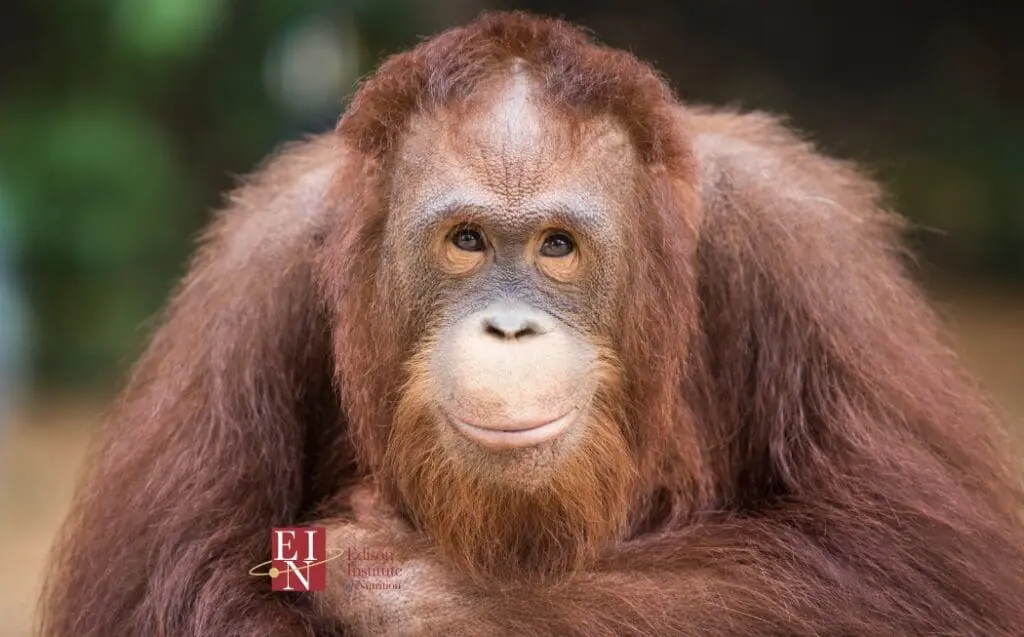Doctor Orangutan, I Presume
Rakus, is in his 30’s. He strolls through the equatorial forest in the northern part of the Indonesian island of Sumatra. He sports a nasty injury on his face below his right eye and decides, in the absence of a surgeon or an emergency room physician nearby, to treat himself. He plucks a few Fibraurea tinctoria leaves, called “akar kuning” by the Indonesians. This plant is known for its medicinal properties and is used by indigenous people in their traditional medicine. Rakus chews the leaves until they form a sort of paste and then applies this medicinal herb mixture to his wound, repeating the process for several minutes.
This self-medication might seem trivial, but Rakus is not a lost hiker in the jungle. He is an orangutan. This great ape was observed in June, 2022 by a team of researchers in the Sumatran jungle who were studying orangutans. Rakus, as they affectionately named him (since he didn’t introduce himself), has been known to them since 2009. This case of plant self-medication was the subject of a recent publication in Nature. Great apes like Rakus have 97% of their genome in common with humans.
An Effective Treatment Using Medicinal Herbs
It is unclear how Rakus was injured. One of the most probable hypotheses is a fall, because orangutans spend their lives in trees. It is common for them to occasionally tumble down from over 10 m. Or, perhaps, Rakus had a scuffle with a fellow orangutan.
The researchers observed the monkey’s injury on June 22, 2022. Three days later, Rakus began his medicinal herb treatment.
The facts:
- the preparation of the poultice took an unusually long time (13 minutes)
- this plant is rarely consumed by orangutans
- the ape treated his wound for 7 minutes on multiple occasions
These facts indicated, according to the researchers, that this operation was intentional and that Rakus applied this mixture to his wound “knowingly.”
“It is important to note that he only put the liquid from the plant on the wound and nowhere else on his body,” stressed Isabelle Laumer, PhD. A primatologist at the Max Planck Institute of Animal Behavior in Konstanz, Germany, Laumer was the lead author of the study.
Before applying this medicinal herb mixture, the orangutan chewed akar kuning leaves for over 30 minutes (combining oral and topical application despite a lack of recommendations). He appears to have rested more than usual during his recovery. The medicinal herb treatment, prescribed by Rakus, seems to have been particularly effective. A few days later, the researchers observed that the wound had completely healed.
Non-human great apes have been observed medicating themselves in the past. As early as the 1960s, renowned anthropologist, Jane Goodall, noted that chimpanzees consumed medicinal herbs and plants, apparently for therapeutic purposes. However, the topical use of plants to treat wounds has rarely been observed in great apes, seldom in such detail, and never for plants whose therapeutic virtues were known to humans. “This is the first time a wild animal has been truly observed treating its wound with a medicinal herb plant,” said Laumer.
Who Taught Rakus Medicinal Herbs?
In addition to highlighting, once again, the significant similarities between humans and our simian cousins, this study provides insights into how medicine might have emerged at the dawn of humanity. It suggests that plant self-medication behaviors existed in the common ancestor that humans shared with great apes 13 million years ago.
But the question remains: Where did Rakus attend medical school? Did he learn this technique from his fellow orangutans, perhaps from his mother, given that orangutans have a great capacity for social learning?
It’s hard to say because Rakus’s region of origin is unknown, as orangutans move a lot once they reach puberty. It is uncertain whether he has peers among other orangutans in the region. Another possibility is that Rakus accidentally discovered this technique by unknowingly touching his wound with the plant, thus discovering its antiseptic properties. Rakus would then be like the Louis Pasteur or Alexander Fleming of the jungle!
Studies of these furry practitioners, however, are made difficult by deforestation, which destroys the natural habitat of our distant cousins. There are now only about 14,000 orangutans left on Sumatra. The equatorial forest is at risk of becoming a medical desert.
This story was translated from JIM, which is part of the Medscape professional network, using several editorial tools, including AI, as part of the process. Human editors reviewed this content before publication. Medscape Medical News © 2024 WebMD, LLC
At Edison Institute of Nutrition, our Diploma in Holistic Nutrition program includes our Herbal Medicine course. It is designed to explore traditional herbalism, in order to understand the origin and use of medicinal herbs worldwide. You will study the relationship of plants to healing, the chemistry and action of herbs, and how to gather and prepare herbal remedies. As you delve into over 500 herbs and remedies for common ailments, you will learn how they relate to healing the body, and, specifically, about the most appropriate medicinal herbs recommended to address specific symptoms safely. Like Rakus, you will feel secure in the knowledge that you will be able to handle many of your own “wounds” with safe, tried, and true methods of healing.

